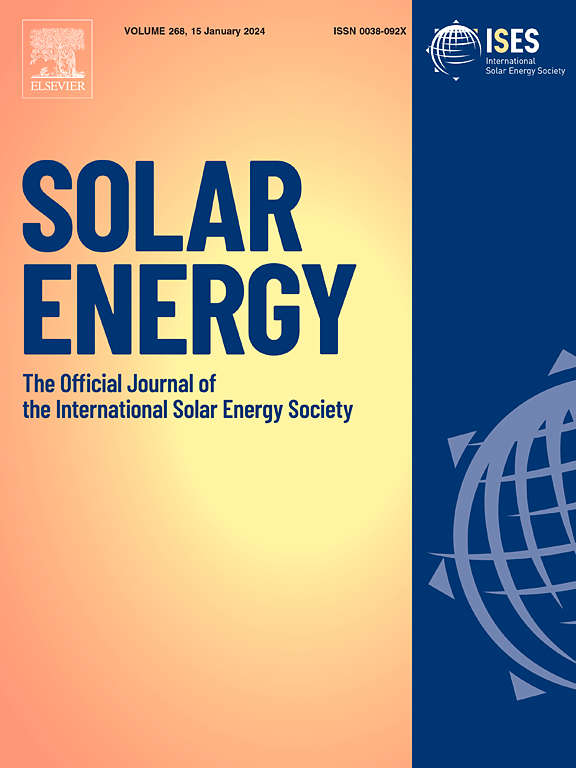Innovative synthesis of Sb8O11Cl2·6H2O/g-C3N4 heterojunction composites via hydrolysis of Cs3Sb2Cl9 perovskite: A novel and effective photocatalyst for solar-driven wastewater treatment
IF 6
2区 工程技术
Q2 ENERGY & FUELS
引用次数: 0
Abstract
In recent years, considerable attention has been directed towards the advancement of innovative composites for the remediation of environmental pollutants. This research initially corroborates the conversion of Cs3Sb2Cl9 perovskite to Sb8O11Cl2·6H2O through hydrolysis reactions upon contact with water. Consequently, novel Sb8O11Cl2·6H2O/g-C3N4 (SOC.H/g-CN) composites are synthesized by groundbreaking exploitation of a straightforward hydrolysis of Cs3Sb2Cl9 within aqueous medium, incorporating g-C3N4 nanoparticles. A comparative assessment of the photocatalytic performance of these samples in degrading of methyl orange (MO) and tetracycline (TC) reveals an exceptional enhancement in photocatalytic efficiency of the SOC.H/g-CN composites as opposed to the pure photocatalysts. After 100 min of exposure to simulated sunlight, the SOC.H/g-CN-20 composite achieves an impressive degradation rate of approximately 98.4 % (k = 0.0522 min−1) and 93.6 % (k = 0.0261 min−1) for MO and TC, respectively. Moreover, the optimized composite’s photocatalytic effectiveness is further corroborated through degradation studies of Rhodamine B (RhB) and 4-nitrophenol (4-NP), yielding rates of 99.6 and 71.2 %, respectively. The superior photocatalytic efficacy of this composite is ascribed to enhanced photoharvesting abilities, improved charge carrier separation, and a decreased recombination rate of photoinduced charge pairs resulting from the building of a type-II heterojunction between Sb8O11Cl2·6H2O and g-C3N4. Additionally, radical-trapping experiments underscore the main role of •O2− radicals in the photocatalytic reactions. The SOC.H/g-CN-20 composite also demonstrates notable operational stability, retaining over 96 % of its photocatalytic efficiency following five sequential cycles. Altogether, this study introduces a pioneering approach for the development of composite solar-driven photocatalysts effective in the elimination of wastewater pollutants.

Cs3Sb2Cl9钙钛矿水解合成Sb8O11Cl2·6H2O/g-C3N4异质结复合材料:一种新型有效的太阳能驱动废水处理光催化剂
近年来,创新复合材料在环境污染物修复中的应用备受关注。本研究初步证实了Cs3Sb2Cl9钙钛矿与水接触后通过水解反应转化为Sb8O11Cl2·6H2O。因此,通过在水介质中直接水解Cs3Sb2Cl9,并加入g-C3N4纳米颗粒,合成了新型Sb8O11Cl2·6H2O/g-C3N4 (SOC.H/g-CN)复合材料。对这些样品在降解甲基橙(MO)和四环素(TC)中的光催化性能进行了比较评估,结果表明,与纯光催化剂相比,SOC.H/g-CN复合材料的光催化效率有显著提高。100 分钟后暴露于模拟阳光,SOC.H / g-CN-20复合达到一个令人印象深刻的降解率大约98.4 % (0.0522 k = 分钟−1)和93.6 % (0.0261 k = 分钟−1)莫和TC,分别。此外,通过对罗丹明B (RhB)和4-硝基苯酚(4-NP)的降解研究,进一步证实了优化后的复合材料的光催化效果,收率分别为99.6%和71.2 %。由于Sb8O11Cl2·6H2O与g-C3N4之间建立了ii型异质结,增强了光捕获能力,改善了电荷载流子分离,降低了光诱导电荷对的重组率,因此该复合材料具有优异的光催化效果。此外,自由基捕获实验强调了•O2−自由基在光催化反应中的主要作用。SOC.H/g-CN-20复合材料也表现出显著的操作稳定性,在五个连续循环后保持超过96% %的光催化效率。总之,这项研究为开发有效消除废水污染物的复合太阳能驱动光催化剂提供了一种开创性的方法。
本文章由计算机程序翻译,如有差异,请以英文原文为准。
求助全文
约1分钟内获得全文
求助全文
来源期刊

Solar Energy
工程技术-能源与燃料
CiteScore
13.90
自引率
9.00%
发文量
0
审稿时长
47 days
期刊介绍:
Solar Energy welcomes manuscripts presenting information not previously published in journals on any aspect of solar energy research, development, application, measurement or policy. The term "solar energy" in this context includes the indirect uses such as wind energy and biomass
 求助内容:
求助内容: 应助结果提醒方式:
应助结果提醒方式:


